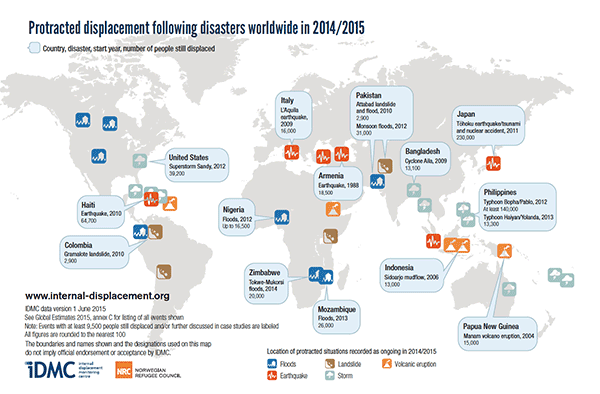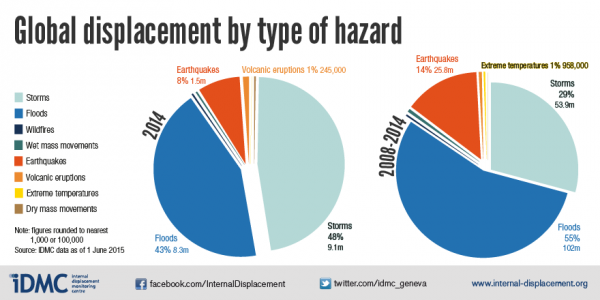Could the Issue of Environmental Refugees Dominate the 21st Century?
Apr 2nd, 2017 | By admin | Category: Social JusticeBy Candela Vázquez Asenjo, youth blogger, Transition Earth.
Today’s news is filled with stories of people who must leave their countries due to violence or extreme conditions of poverty. However, little attention is given to the victims who migrate because their homes have disappeared due to environmental deterioration. Yet this is becoming common. In fact, refugees from environmental disasters have surpassed people fleeing from armed conflicts.This new type of refugees, sometimes called “environmental immigrants,” face a lack of international recognition, causing them to receive no help from the United Nations as many are not chased after or are just moving within the limits of their countries.
Currently, the clearest case of this is the Republic of Kiribati in the Pacific Ocean, which surpassed the inflection point years ago. Although its disappearance is inevitable, this apocalyptic view is not new – in 1989 a United Nations report on “greenhouse effect” declared that this country would be the one of many which would be swallowed by the rise in the seas.
Defining Environmental Refugees
As defined by the UN, these refugees won’t be classified into this category and thus they lose all type of legal protection, with the result that they become meaningless in the realm of international law. Therefore, the problem lies in an urgent need to establish a new definition for “environmental immigrant” and to recognize this at the international level.
According to the United Nations High Commissioner for Refugees (UNHCR), refugees are considered as “the people that have left their country for fear of a persecution of race, religion or political opinion” per the Geneva Convention. However, it recognizes that people displaced by catastrophes have similar basic needs, as well as the need for protection.
The International Organization for Migration (IOM) has been working on the definition for environmental migration, currently defined “as persons who are obliged, or choose to leave their home due to sudden or progressive environmental changes that adversely affect their lives or living conditions.”
Some countries, such as Sweden and Finland, do include “environmental immigrants” as a special category of people who need protection. However, the truth is that international law does not oblige the States to give refuge to those people who have been displaced due to environmental reasons.
Following the IOM’s report, environmental migration is more likely to occur within the borders of developing countries rather than across national borders. And it is most likely to happen in developing countries that do not have the monetary strength to handle these events.
A Pressing Concern
A report by the Norwegian Refugee Council (NRC) indicated that in 2014 more than 19 million people had to abandon their houses due to natural disasters such as floods, storms or earthquakes. It’s estimated that, since 2008, one person has been forced to leave everything behind for these reasons every second. Moreover, 70 people are being displaced for environmental reasons every minute, with Asia, Africa (sub-Saharan region) and South America the most impacted continents. Europe and the U.S. have been affected (and somewhat unprepared) by the growing migration coming from North Africa and Latin America.
In addition, the UNHCR informs that in the next 50 years between 250 and 1,000 million people will be compelled to move to another region in their country or to another state. Furthermore, a study from the University of the United Nations estimates that in five years’ time there will be 50 million refugees or “environmental immigrants” in the world. The investigation found that droughts, poor soil, deforestation and floods have forced 25 million people to leave their countries.
The rector of the University of the UN, Hans van Ginkel, has stated that while most of the economic refugees are young men, the victims from environmental catastrophes are mainly women and children. He also added that there are more cases than the ones we know of which get even less help.
Finding Solutions That Support People
So, in the end, what happens with the people who must leave their homes due to environmental reasons? Sadly, many environmental refugees are rejected by the countries to which they flee. Some people go directly to refugee camps and a lucky minority is received into neighbouring countries, which allows them to start a new life before their home country disappears. Only New Zealand has thus far accepted the people from Kiribati.
Where can we find a solution? As mentioned above, the problem resides in the establishment of a technical, applicable and worldwide recognisable definition for the “environmental immigrants.” Until then, little can be done as countries are not obligated to help these people. Preparation for the new wave that will come – and it will as climate impacts become more and more severe – is the key to find the most suitable and humane solution for the people who have lost everything.
Candela Vázquez Asenjo is an Environmental Management student at the University of Manchester, UK, and a Law student at the Nebrija University, Spain. She aspires to be a social entrepreneur, with a focus on international environmental problems.

![[photo credit: http://www.unhcr.org]](http://populationgrowth.org/wp-content/uploads/2017/04/env-refugees-300x199.jpg)

